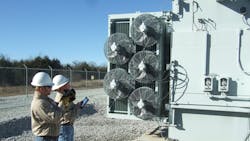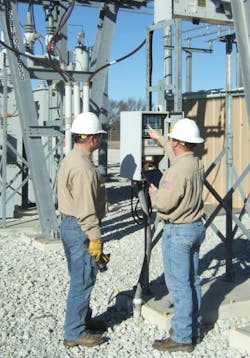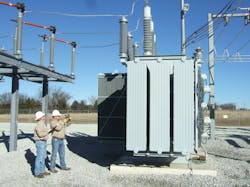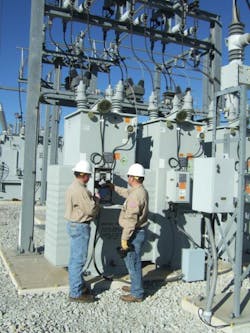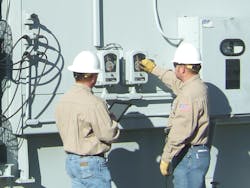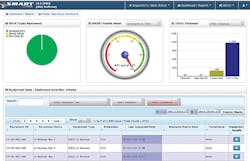People’s Electric Manages a Tidal Wave of Assets
Today’s electric utilities are challenged with handling numerous conflicting issues. Infrastructure is aging and reliability requirements are changing just as utilities are trying to control costs. Added to that, utilities must handle operational uncertainties while simultaneously satisfying non-static regulatory agency requirements. All of this can be a daunting balancing act. But, inject a sudden influx of new substations that increases assets to be managed and operated by 350%, and things get really complicated, really fast.
In 2012, People’s Electric Cooperative (PEC) acquired 15 distribution substations and the radial transmission taps from Western Farmers Electric Cooperative. Prior to the acquisition, PEC owned six substations and 30 miles (48 km) of transmission lines. Therefore, the acquisition radically increased the substation portion of PEC assets, creating a massive technical and management challenge.
PEC’s asset expansion normally would result in a commensurate growth in support staff and management. Instead, the cooperative is relying on its current staff of skilled field journeymen and technicians to navigate the expansion successfully. The goal was to manage the increase in asset inventory of 3.5 and not increase staff requirements. Realization of this goal started with an immediate review of technology options.
A Relationship with Technology
Asset management seeks to stabilize and balance performance, cost and risk. Achieving this equilibrium requires the alignment of corporate goals, management decisions and technical decisions. PEC has consistently used technology to simplify operations.
In the early 1990s, the cooperative installed full supervisory control and data acquisition (SCADA) capabilities in all of its substations, including those owned by its power supplier. This was long before the term “smart grid” was such a buzzword in the cooperative market or the utility industry as a whole.
The SCADA implementation included both hardwired and fiber-optic status, telemetry and control of all substation reclosers and voltage regulation, in addition to monitoring of transformer alarms, metering accumulators and instantaneous metering values at the substation and feeder level. As a fuse-saving measure, control algorithms were developed to reprogram the recloser controls for fast-trip capability when storms approached. The appropriate upgrades have been applied to keep up with current technology.
With the introduction of Microsoft Windows 95, PEC installed laptop computers in its maintenance and construction vehicles. Updated customer information and maps of the distribution system were downloaded on a scheduled basis, allowing field access to this information along with other important cooperative-supplied information regarding procedures and specifications. Today, more current and technologically advanced data is transmitted to the Windows 7 truck laptops on a real-time basis through a radio link. Service orders are assigned, received and completed by radio link while the vehicle location information is displayed on a distribution system map within the dispatch center.
PEC recently completed an asset identification project that provided geographic information system (GIS) identification and location information for all infrastructures in the field such as poles, units attached to the poles and wire. Every pole is numbered with a unique identifier in the field, which is tied to the particular information about that pole. The information electronically attached to the pole includes pole height, class, framing, span footages, conductor size and other pertinent information. This allows staking to be accomplished electronically for any existing structure in addition to an accurate, current field inventory.
In 2010, PEC contracted with NewSpin to develop a photographic virtual tour for each PEC substation. Dispatch personnel now have a visual record that allows them to see exactly what field personnel see in a particular substation. In addition to a 360-degree view of the substation, close-up pictures of the nameplates of the equipment and control panels are accessible with a zoom feature so the finest detail can be read. Equipment details such as model number and rating are specified inside links posted within the 360-degree view. This technology puts dispatch personnel and field technicians on the same page, avoiding any miscommunication.
Assets such as poles, capacitor banks, padmounted transformers and vaults are mapped on an integrated GIS application. This information is used to group, assign and coordinate service issues to area crews. This prevents sending resources to a service call when other issues needing service are in the immediate vicinity, thus saving the distribution services department time and reducing the need for increased manpower.
Asset Management Requirements
Tracking the day-to-day and long-term conditions as well as the potential maintenance needs of the newly acquired assets was a priority for PEC. A computerized system was needed to build an organized database of the assets. The coop began by creating a must-have list of features in the new system.
PEC needed an inspection and asset management tool that worked the way its field technicians work. It had to be able to store important nameplate details and additional data as needed for each asset and substation as a whole. Additionally, the tool had to be able to guide the field technicians through the inspection procedures step by step. Every inspection, work order or service call needed to be handled in the exact same manner and all of the results stored in such a way that compliance and management reports could be easily and rapidly produced.
In addition, the new tool had to reduce audit time by providing easy access to any data that has been observed, and certain audit rules prohibiting changes of the gathered information had to be built in. PEC wanted to be able to perform analytics based on its inspection data. These studies shift the maintenance practices away from condition- or time-based activity toward reliability-centered maintenance.
The system needed to be role based, which would allow field engineers and managers to do their individual jobs. The superintendent or chief engineer had to be able to create an inspection procedure and have the inspection program build the appropriate inspection process.
The system had to be able to train itself on how the user inspects equipment inside and outside the fence. The application would then need to learn the technician’s path and habits, and duplicate this pattern of inspection during subsequent missions. Each technician’s pathway needed to be memorized to accommodate individual preferences.
All of the automatic processes would save time and increase equipment reliability by eliminating errors. Increasing reliability was the key objective that would allow PEC to manage the dramatic increase in assets with its existing workforce.
Getting SMART
In its search for innovative software solutions, PEC was introduced to a powerful inspection and asset management software called Substation Maintenance & Asset Reliability Tracking (SMART), designed and created by MinMax Technologies. PEC learned that MinMax has worked with EPRI member utilities and is known for its commitment to project success.
SMART includes a library of equipment categories and the appropriate inspection procedures for each. These procedures have been specified by the IEEE, Rural Utilities Service, North American Electric Reliability Corp. and other regulatory agencies. MinMax also has spent considerable time studying these procedures and reviewing them with the Texas Reliability Entity and Schneider Engineering to validate the implementation of the software.
SMART is a mobile product that runs on any web browser-enabled device. When in the proximity of a stable, secure Wi-Fi connection, the application is in constant contact with its database. This makes drawings, manuals, pictures and other digital assets immediately available. Digital values of readings can be validated to preset ranges and historical readings can be checked. When a device is out of Wi-Fi range, SMART downloads the necessary data and procedures, and then stores the input data until the device is back in Wi-Fi range, where it safely uploads the data to the cloud.
MinMax not only provides the cloud-based software system through a secure third-party cyber center, but it also provides the manpower to load or convert the asset data, drawings, equipment manuals, computer-aided design drawings, one-line drawings and equipment test results. All of the necessary digital assets are stored in the customer’s database.
Implementation of the PEC system involved listing the name and type of equipment in each substation. The data was located, put into spreadsheets, loaded into SMART, conditioned, validated and accepted in only 12 days. After the data is loaded, MinMax trains and provides continued support to field technicians while working with managers to achieve the completed solution.
Having chosen the Substation Maintenance & Asset Reliability Tracking software, PEC is feeling pretty SMART.
John W. Hudson ([email protected]) joined People’s Electric Cooperative in 1975 and is senior vice president of operations and engineering. He is responsible for the management of the operations and engineering division as well as the development of resources to meet current and long-term goals and commitments.
Billy R. Huffman ([email protected]) joined People’s Electric Cooperative in 1981, and has served as a journeyman lineman, journeyman meter technician and supervisor of metering. Currently, as manager of distribution services, he oversees technical services, maintenance services, construction services, fleet services, SCADA/environmental services, vegetation management and substation/transmission services.
Companies mentioned:
Cooper Industries | www.cooperindustries.com
Electric Power Research Institute | www.epri.com
IEEE | www.ieeeusa.org
MinMax Technologies | www.minmaxtech.com
NewSpin | www.newspin360.com
North American Electric Reliability Corp. | www.nerc.com
People’s Electric Cooperative | www.peopleselectric.coop
Rural Utilities Service | www.rurdev.usda.gov
Schneider Engineering | www.se-texas.com
Texas Reliability Entity | www.texasre.org
